Mengjie Zhao
VinaBench: Benchmark for Faithful and Consistent Visual Narratives
Mar 26, 2025
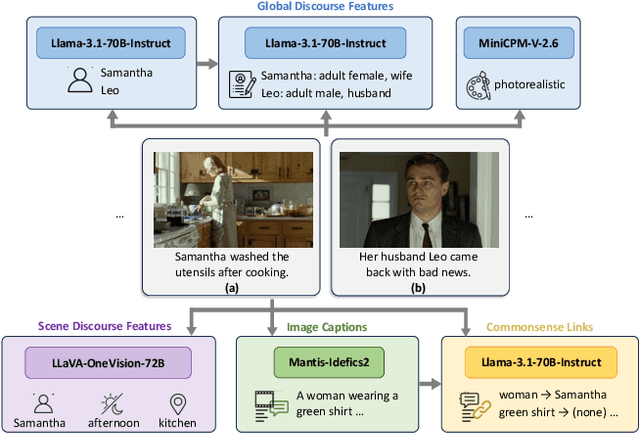
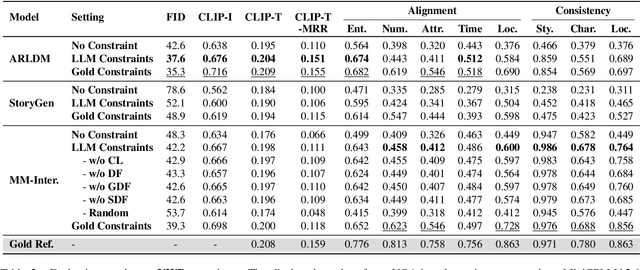
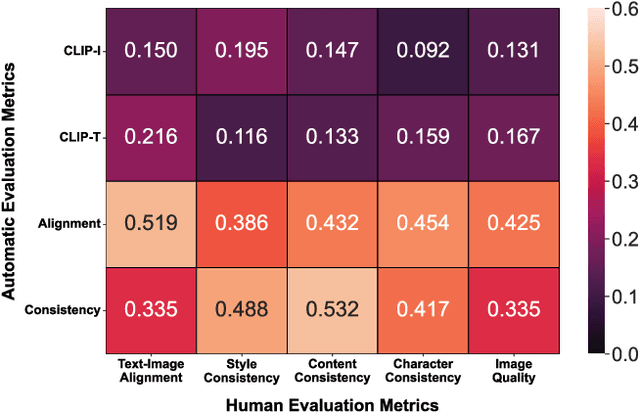
Abstract:Visual narrative generation transforms textual narratives into sequences of images illustrating the content of the text. However, generating visual narratives that are faithful to the input text and self-consistent across generated images remains an open challenge, due to the lack of knowledge constraints used for planning the stories. In this work, we propose a new benchmark, VinaBench, to address this challenge. Our benchmark annotates the underlying commonsense and discourse constraints in visual narrative samples, offering systematic scaffolds for learning the implicit strategies of visual storytelling. Based on the incorporated narrative constraints, we further propose novel metrics to closely evaluate the consistency of generated narrative images and the alignment of generations with the input textual narrative. Our results across three generative vision models demonstrate that learning with VinaBench's knowledge constraints effectively improves the faithfulness and cohesion of generated visual narratives.
Cross-Modal Learning for Music-to-Music-Video Description Generation
Mar 14, 2025Abstract:Music-to-music-video generation is a challenging task due to the intrinsic differences between the music and video modalities. The advent of powerful text-to-video diffusion models has opened a promising pathway for music-video (MV) generation by first addressing the music-to-MV description task and subsequently leveraging these models for video generation. In this study, we focus on the MV description generation task and propose a comprehensive pipeline encompassing training data construction and multimodal model fine-tuning. We fine-tune existing pre-trained multimodal models on our newly constructed music-to-MV description dataset based on the Music4All dataset, which integrates both musical and visual information. Our experimental results demonstrate that music representations can be effectively mapped to textual domains, enabling the generation of meaningful MV description directly from music inputs. We also identify key components in the dataset construction pipeline that critically impact the quality of MV description and highlight specific musical attributes that warrant greater focus for improved MV description generation.
DeepResonance: Enhancing Multimodal Music Understanding via Music-centric Multi-way Instruction Tuning
Feb 18, 2025Abstract:Recent advancements in music large language models (LLMs) have significantly improved music understanding tasks, which involve the model's ability to analyze and interpret various musical elements. These improvements primarily focused on integrating both music and text inputs. However, the potential of incorporating additional modalities such as images, videos and textual music features to enhance music understanding remains unexplored. To bridge this gap, we propose DeepResonance, a multimodal music understanding LLM fine-tuned via multi-way instruction tuning with multi-way aligned music, text, image, and video data. To this end, we construct Music4way-MI2T, Music4way-MV2T, and Music4way-Any2T, three 4-way training and evaluation datasets designed to enable DeepResonance to integrate both visual and textual music feature content. We also introduce multi-sampled ImageBind embeddings and a pre-alignment Transformer to enhance modality fusion prior to input into text LLMs, tailoring DeepResonance for multi-way instruction tuning. Our model achieves state-of-the-art performances across six music understanding tasks, highlighting the benefits of the auxiliary modalities and the structural superiority of DeepResonance. We plan to open-source the models and the newly constructed datasets.
OpenMU: Your Swiss Army Knife for Music Understanding
Oct 21, 2024



Abstract:We present OpenMU-Bench, a large-scale benchmark suite for addressing the data scarcity issue in training multimodal language models to understand music. To construct OpenMU-Bench, we leveraged existing datasets and bootstrapped new annotations. OpenMU-Bench also broadens the scope of music understanding by including lyrics understanding and music tool usage. Using OpenMU-Bench, we trained our music understanding model, OpenMU, with extensive ablations, demonstrating that OpenMU outperforms baseline models such as MU-Llama. Both OpenMU and OpenMU-Bench are open-sourced to facilitate future research in music understanding and to enhance creative music production efficiency.
GLOV: Guided Large Language Models as Implicit Optimizers for Vision Language Models
Oct 08, 2024



Abstract:In this work, we propose a novel method (GLOV) enabling Large Language Models (LLMs) to act as implicit Optimizers for Vision-Langugage Models (VLMs) to enhance downstream vision tasks. Our GLOV meta-prompts an LLM with the downstream task description, querying it for suitable VLM prompts (e.g., for zero-shot classification with CLIP). These prompts are ranked according to a purity measure obtained through a fitness function. In each respective optimization step, the ranked prompts are fed as in-context examples (with their accuracies) to equip the LLM with the knowledge of the type of text prompts preferred by the downstream VLM. Furthermore, we also explicitly steer the LLM generation process in each optimization step by specifically adding an offset difference vector of the embeddings from the positive and negative solutions found by the LLM, in previous optimization steps, to the intermediate layer of the network for the next generation step. This offset vector steers the LLM generation toward the type of language preferred by the downstream VLM, resulting in enhanced performance on the downstream vision tasks. We comprehensively evaluate our GLOV on 16 diverse datasets using two families of VLMs, i.e., dual-encoder (e.g., CLIP) and encoder-decoder (e.g., LLaVa) models -- showing that the discovered solutions can enhance the recognition performance by up to 15.0% and 57.5% (3.8% and 21.6% on average) for these models.
Mining Your Own Secrets: Diffusion Classifier Scores for Continual Personalization of Text-to-Image Diffusion Models
Oct 02, 2024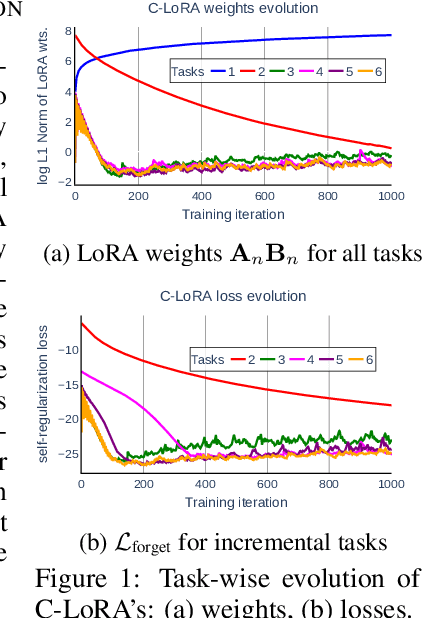
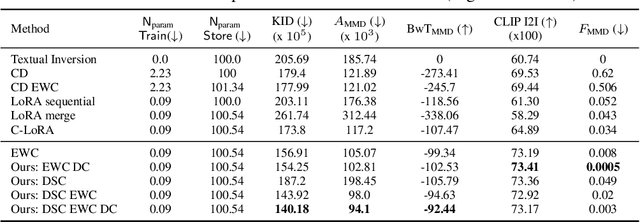
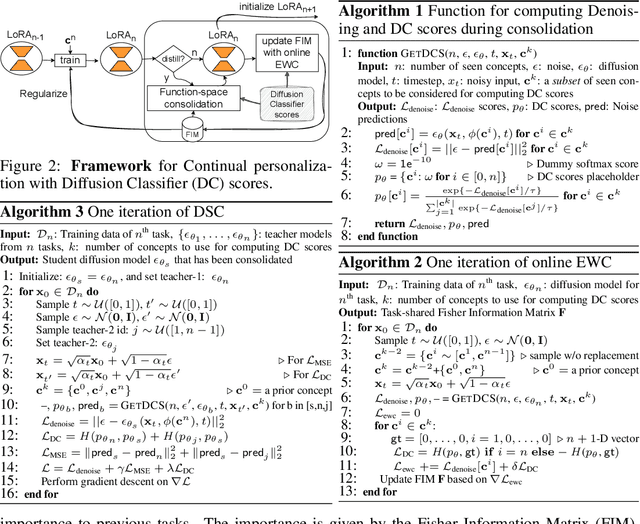
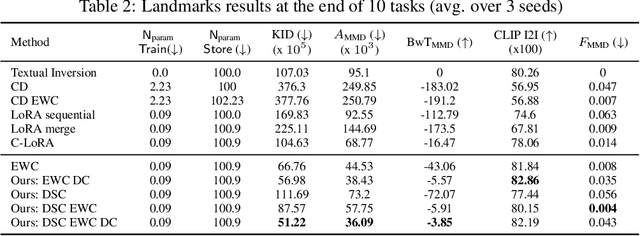
Abstract:Personalized text-to-image diffusion models have grown popular for their ability to efficiently acquire a new concept from user-defined text descriptions and a few images. However, in the real world, a user may wish to personalize a model on multiple concepts but one at a time, with no access to the data from previous concepts due to storage/privacy concerns. When faced with this continual learning (CL) setup, most personalization methods fail to find a balance between acquiring new concepts and retaining previous ones -- a challenge that continual personalization (CP) aims to solve. Inspired by the successful CL methods that rely on class-specific information for regularization, we resort to the inherent class-conditioned density estimates, also known as diffusion classifier (DC) scores, for continual personalization of text-to-image diffusion models. Namely, we propose using DC scores for regularizing the parameter-space and function-space of text-to-image diffusion models, to achieve continual personalization. Using several diverse evaluation setups, datasets, and metrics, we show that our proposed regularization-based CP methods outperform the state-of-the-art C-LoRA, and other baselines. Finally, by operating in the replay-free CL setup and on low-rank adapters, our method incurs zero storage and parameter overhead, respectively, over the state-of-the-art.
Graph Neural Networks for Virtual Sensing in Complex Systems: Addressing Heterogeneous Temporal Dynamics
Jul 26, 2024



Abstract:Real-time condition monitoring is crucial for the reliable and efficient operation of complex systems. However, relying solely on physical sensors can be limited due to their cost, placement constraints, or inability to directly measure certain critical parameters. Virtual sensing addresses these limitations by leveraging readily available sensor data and system knowledge to estimate inaccessible parameters or infer system states. The increasing complexity of industrial systems necessitates deployments of sensors with diverse modalities to provide a comprehensive understanding of system states. These sensors capture data at varying frequencies to monitor both rapid and slowly varying system dynamics, as well as local and global state evolutions of the systems. This leads to heterogeneous temporal dynamics, which, particularly under varying operational end environmental conditions, pose a significant challenge for accurate virtual sensing. To address this, we propose a Heterogeneous Temporal Graph Neural Network (HTGNN) framework. HTGNN explicitly models signals from diverse sensors and integrates operating conditions into the model architecture. We evaluate HTGNN using two newly released datasets: a bearing dataset with diverse load conditions for bearing load prediction and a year-long simulated dataset for predicting bridge live loads. Our results demonstrate that HTGNN significantly outperforms established baseline methods in both tasks, particularly under highly varying operating conditions. These results highlight HTGNN's potential as a robust and accurate virtual sensing approach for complex systems, paving the way for improved monitoring, predictive maintenance, and enhanced system performance.
SpecMaskGIT: Masked Generative Modeling of Audio Spectrograms for Efficient Audio Synthesis and Beyond
Jun 26, 2024



Abstract:Recent advances in generative models that iteratively synthesize audio clips sparked great success to text-to-audio synthesis (TTA), but with the cost of slow synthesis speed and heavy computation. Although there have been attempts to accelerate the iterative procedure, high-quality TTA systems remain inefficient due to hundreds of iterations required in the inference phase and large amount of model parameters. To address the challenges, we propose SpecMaskGIT, a light-weighted, efficient yet effective TTA model based on the masked generative modeling of spectrograms. First, SpecMaskGIT synthesizes a realistic 10s audio clip by less than 16 iterations, an order-of-magnitude less than previous iterative TTA methods. As a discrete model, SpecMaskGIT outperforms larger VQ-Diffusion and auto-regressive models in the TTA benchmark, while being real-time with only 4 CPU cores or even 30x faster with a GPU. Next, built upon a latent space of Mel-spectrogram, SpecMaskGIT has a wider range of applications (e.g., the zero-shot bandwidth extension) than similar methods built on the latent wave domain. Moreover, we interpret SpecMaskGIT as a generative extension to previous discriminative audio masked Transformers, and shed light on its audio representation learning potential. We hope our work inspires the exploration of masked audio modeling toward further diverse scenarios.
ComperDial: Commonsense Persona-grounded Dialogue Dataset and Benchmark
Jun 17, 2024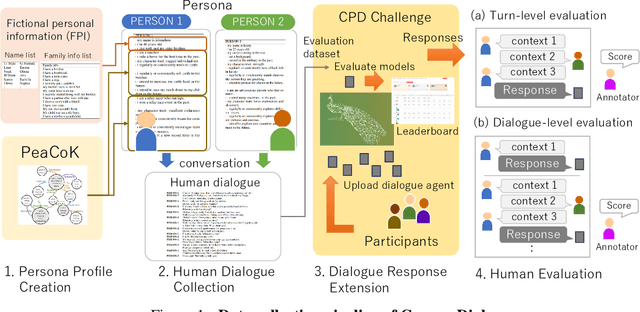

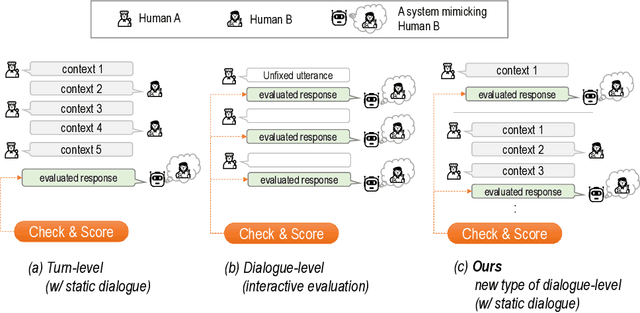
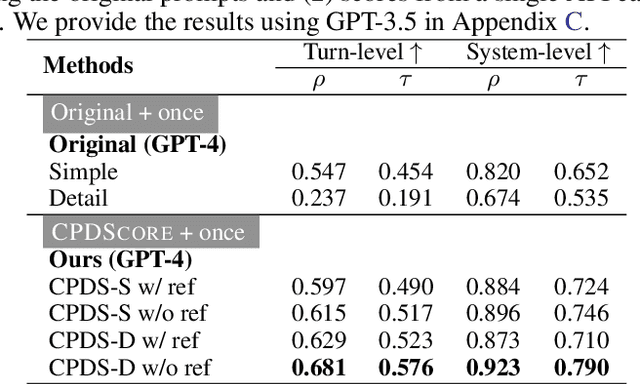
Abstract:We propose a new benchmark, ComperDial, which facilitates the training and evaluation of evaluation metrics for open-domain dialogue systems. ComperDial consists of human-scored responses for 10,395 dialogue turns in 1,485 conversations collected from 99 dialogue agents submitted to the Commonsense Persona-grounded Dialogue (CPD) challenge. As a result, for any dialogue, our benchmark includes multiple diverse responses with variety of characteristics to ensure more robust evaluation of learned dialogue metrics. In addition to single-turn response scores, ComperDial also contains dialogue-level human-annotated scores, enabling joint assessment of multi-turn model responses throughout a dialogue. Finally, building off ComperDial, we devise a new automatic evaluation metric to measure the general similarity of model-generated dialogues to human conversations. Our experimental results demonstrate that our novel metric, CPDScore is more correlated with human judgments than existing metrics. We release both ComperDial and CPDScore to the community to accelerate development of automatic evaluation metrics for open-domain dialogue systems.
Visual Echoes: A Simple Unified Transformer for Audio-Visual Generation
May 23, 2024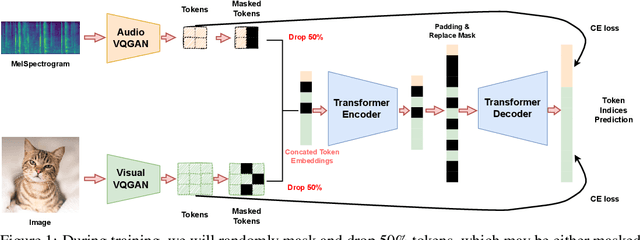

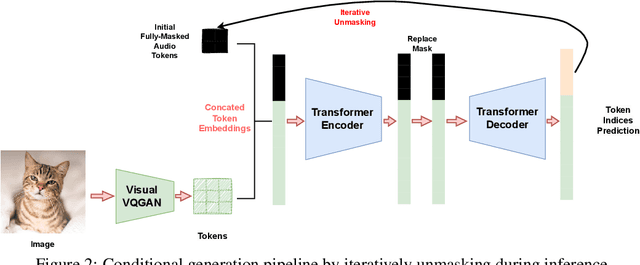
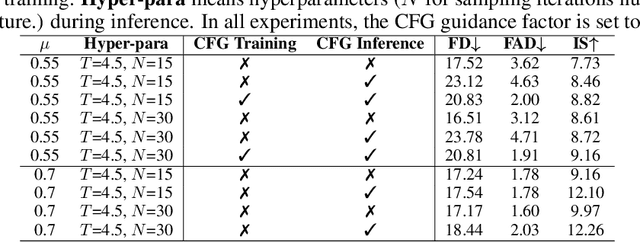
Abstract:In recent years, with the realistic generation results and a wide range of personalized applications, diffusion-based generative models gain huge attention in both visual and audio generation areas. Compared to the considerable advancements of text2image or text2audio generation, research in audio2visual or visual2audio generation has been relatively slow. The recent audio-visual generation methods usually resort to huge large language model or composable diffusion models. Instead of designing another giant model for audio-visual generation, in this paper we take a step back showing a simple and lightweight generative transformer, which is not fully investigated in multi-modal generation, can achieve excellent results on image2audio generation. The transformer operates in the discrete audio and visual Vector-Quantized GAN space, and is trained in the mask denoising manner. After training, the classifier-free guidance could be deployed off-the-shelf achieving better performance, without any extra training or modification. Since the transformer model is modality symmetrical, it could also be directly deployed for audio2image generation and co-generation. In the experiments, we show that our simple method surpasses recent image2audio generation methods. Generated audio samples can be found at https://docs.google.com/presentation/d/1ZtC0SeblKkut4XJcRaDsSTuCRIXB3ypxmSi7HTY3IyQ
 Add to Chrome
Add to Chrome Add to Firefox
Add to Firefox Add to Edge
Add to Edge